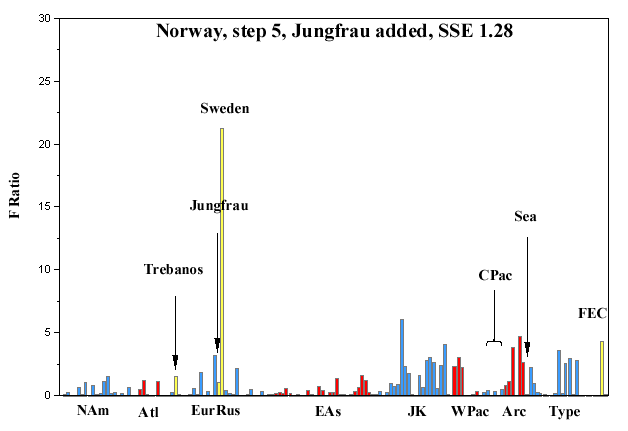
Apportionment of Northern Norway
Northern Norway is a very interesting location with respect
to large-scale transport of aerosol in northwestern Eurasia. It is far enough
north to receive frequent doses of Arctic aerosol (like Arctic haze) in the
winter, but it is also far enough south and west to receive aerosol from Europe,
occasionally in strong pulses. Thus we should not be surprised if the
apportionments reflect these two different types of sources.
As with the Elms aerosol, we illustrate three possible
solutions (threads), one with European sources, one with Arctic
sources (really receptor sites), and one with Japanese sources. They branch from step 2
(sea and crust). The overall map is shown in the table below.
|
Northern Norway, 22 elements |
|||
| Step 0 | |||
| Step 2 | |||
| Step 3 | Add Sweden, fit 1.52 | Add Norilsk, fit 1.59 | Add Matsue (JP), fit 2.33 |
| Step 4 | Add Trebanos, for 1.36 | Add Ny-Ålesund, fit 1.46 | Add Seoul winter, fit 2.08 |
| Step 5 | Add Jungfraujoch, fit 1.28 | Add Petten, fit 0.89 | |
| Step 6 | Add Norilsk, fit 0.99 | Add Allen, del. Ny-Ål, fit 0.72 | |
| Step 7 | Add Petten (NL), del. Jung., fit 0.86 | ||
| Step 8 | Add Allen, fit 0.70 | ||
The apportionments of the European thread are displayed below. Their sequence is shown in red italic in the table below. For the other two threads, click on Arctic and Japan/Korea.
|
Northern Norway, 22 elements |
|||
| Step 0 |
Nothing chosen |
||
| Step 2 |
Sea and best crust (FEC) chosen |
||
| Step 3 | Add Sweden, fit 1.52 | Add Norilsk, fit 1.59 | Add Matsue (JP), fit 2.33 |
| Step 4 | Add Trebanos, for 1.36 | Add Ny-Ålesund, fit 1.46 | Add Seoul winter, fit 2.08 |
| Step 5 | Add Jungfraujoch, fit 1.28 | Add Petten, fit 0.89 | |
| Step 6 | Add Norilsk, fit 0.99 | Add Allen, del. Ny-Ål, fit 0.72 | |
| Step 7 | Add Petten (NL), del. Jung., fit 0.86 | ||
| Step 8 | Add Allen, fit 0.70 | ||
Step 0, with nothing chosen, displays three major candidates for sources: Europe, parts of Japan/Korea, and the Arctic. These gave rise to the three strands noted above.

When sea and crust (FEC) were chosen in step 2, these three source areas remained the most prominent, but with Japan/Korea reduced relative to the other two.

Step 3 of the European branch chose Sweden, the place with the highest F-ratio in Europe and Russia. It improved the fit to 1.52, which is only borderline satisfactory. Another potential source had to be tried.

The next source was Trebanos, a site in the UK that had next-highest F-ratio in Europe. It improved the fit to 1.36, still not particularly good. The result is shown below.

Step 5 added Jungfraujoch, the best of the remaining sources in Europe. It improved the fit modestly, to 1.28.

European sources still were not exhausted. Step 6 added Norilsk, a large nonferrous smelter in the Taimyr Peninsula, usually considered more an Arctic source than a European. It improved the fit to 0.99. Norilsk may have been substituting for the nearer nonferrous smelter at Nikel (Kola Peninsula), which uses generally similar ores and technology. If so, we do not know why Norilsk was chosen instead. For our purposes here, the difference between the two smelters is less important than that one of them was chosen.

The selection of Norilsk in step 6 raised the F-ratios of several western European sources to prominence. It did the same for some sources in eastern North America and Japan/Korea, but we did not choose them while pursuing a European solution. Instead, we chose Petten (Netherlands), the European site with the highest remaining F-ratio, for step 5. That eliminated Jungfraujoch and produced the good fit of 0.88.

The choice of Petten raised a host of other European F-ratios to values worth considering. But they couldn't be taken, because all their coefficients were negative. Instead, we turned to Allen Steam Coal, the highest of the type-signatures. That improved the fit to 0.70, which was good enough to stop the apportionment.

Thus the final European solution for Northern Norway was Petten, Trebanos, and Sweden for Western Europe, Norilsk for Russia and the Arctic, and Allen Steam Coal (for a little more coal flyash). In short, the European solution for Northern Norway gave a broad-based European source with a touch of Arctic influence.